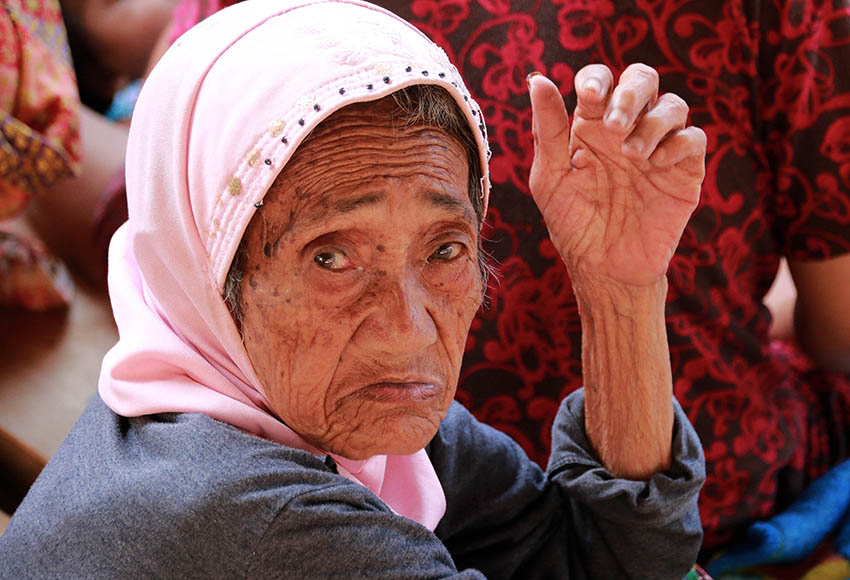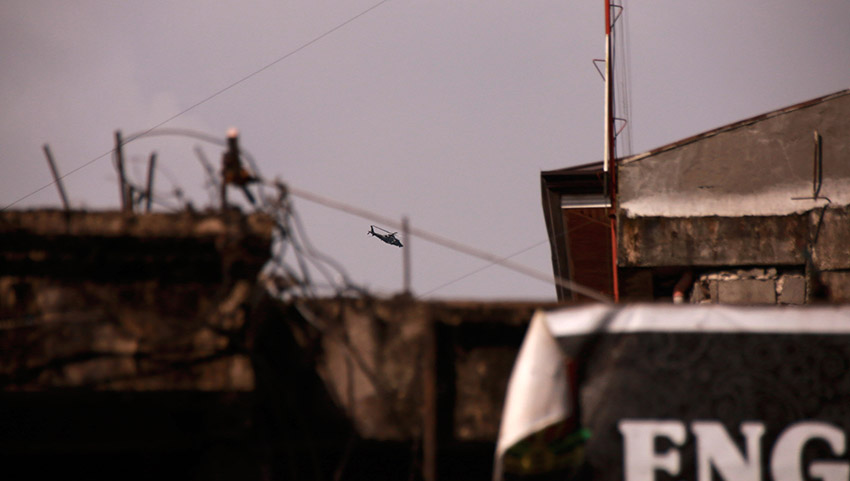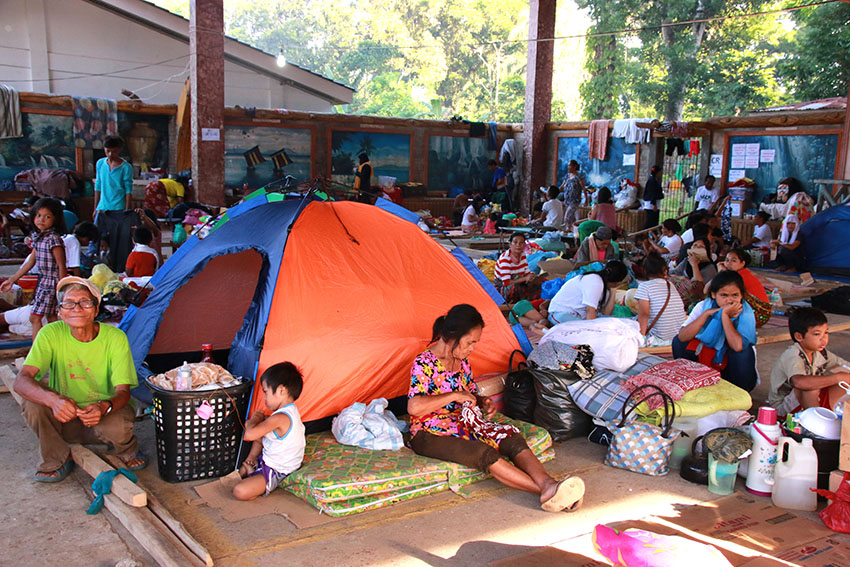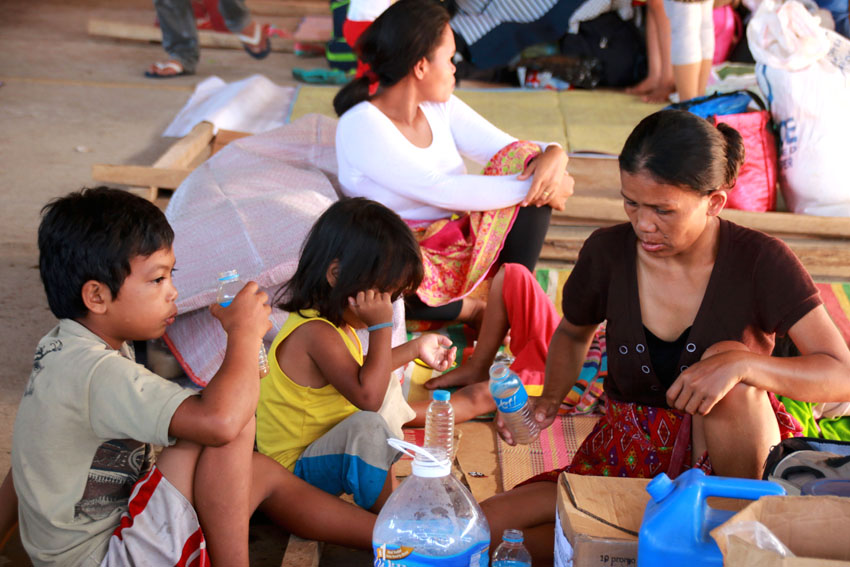
WAITING TO GO HOME – This elderly woman is among the thousands of displaced residents of Marawi who now stays in an evacuation center in Buru-un, Iligan City. She also longs to go home to Marawi as ground operations against the Maute group in the area continue. (Alexander D. Lopez/davaotoday.com)
MARAWI CITY – On the 8th day after armed men attacked this city and Pres. Rodrigo Duterte declared Martial Law in Mindanao, uncertainties and fear painted the face of every resident and they asked: “Until when shall we wait?”
Facing tough times in evacuation centers and temporary shelters – displaced Marawi residents now hang on to an aspiration – and that is to go back to their homes.
But they receive more questions, rather than answers, as they hear updates from the ongoing ground operations of the Armed Forces of the Philippines, the Philippine National Police and other security units of the government.
And they hear harrowing news – the continued air assaults, house-to-house searches, recovery of dead bodies, and other painful facts that war brought in to their city.
What is certain in Marawi, eight days since the war broke out are of two things: one is the doubling of military men with their armaments and war equipment coming into the city; and the other, the swelling of the number of individuals who were dislocated.

(Alexander D. Lopez/davaotoday.com)
“Ang sitwasyon ngayon sa Marawi ay ang totoong mukha ng martial law (The current situation in Marawi manifests the real face of martial law),” a trader, who requested anonymity told davaotoday.com in an interview.
For him, the full military operation might be the outright solution to counter the Maute group but it will not give assurance to “kill” the terrorism that the group started to spread.
“May malalim pa na problema d’yan. Marami pa rin mga mahihirap dyan. S’yempre, merong iba na kailangan talaga ang pera kakapit na lang sa kahit anong bagay para kumita. Ako mahirap din dati pero nagsikap lang para maka-angat sa buhay (There are deeper problems. Many are poor. Others who need money are forced to cling to whatever means just to earn. I once lived in poverty but I strive hard to improve my life),” he added.
Marawi is a fourth class city, the capital of the province of Lanao del Sur and a part of the ARMM with a total population of 201,785 based on 2015 census.
It has a total land area of 8,755 hectares subdivided into 96 barangays.

(Alexander D. Lopez/davaotoday.com)
Civilians killed, displaced
At least 85 lives were already lost after days of fighting – 13 of these were soldiers, two policemen, 51 members of Maute group and 19 civilians.
The total number of civilians killed, 19, included the eight dead bodies found dumped at a ravine near the entrance of Marawi on Sunday, May 28, and that of the three women and a child.
Based on the May 30 data released by the Humanitarian Emergency Action and Response Team of the Autonomous Region in Muslim Mindanao (ARMM-HEART), a total of 140,155 individuals or 28,011 are already affected by the continuing war in Marawi.
Of the total number, 30,645 individuals or 6,129 families are now staying in 38 evacuation centers situated in the provinces of Lanao del Sur and Lanao del Norte.
Other families opted to stay in hotels and inns in Iligan City while some are with their relatives in nearby towns and villages.
“Naipit kami sa bakbakan, sa kabila ang Maute, sa kabila naman ang mga sundalo (We were trapped during the firefight between the Maute group and government troopers),” said Asnawi Marauna, 33, and a father of two from Barangay Guimba.
Asnawi said they already heard of the attacks of the Maute group but did not leave immediately out of fear.
Then, on May 24, the unexpected happened when the armed confrontation took place near their residence.
“Bitbit ko ang dalaw kong anak. Sumunod ang aking asawa. Tumakbo na lang kami basta makalabas lang kami sa mga putukan (I carried my two children while my wife followed. We ran to evade the firefight),” he added.
Asnawi said seven more families from Guimba followed him but he has not heard any news about the fate of most of his neighbors.
“Hindi ko alam kung nasaan sila. Pitong pamilya kami lahat nakarating dito sa Iligan (I don’t know where they are now. We are all seven families who reach Iligan),” he added.
Asnawi and his family are among the 1,546 individuals who were temporarily housed at the Badelles Multi-Purpose Hall inside the Iligan City National High School of Fisheries in Barangay Buru-un.
Most of the evacuees in the multi-purpose hall are children and minors based on the record provided by the Department of Social Welfare and Development of Iligan City.
The data said 36 of the evacuees are infants below 1 year old, 61 are aged 1 to 2 years old; 80 are aged 3 to 4 years old; 83 are aged 5 to 6 years old; 195 are aged 7 to 12 years old; 11 are aged 13 to 15 years old; and 109 are aged 16 to 18 years old.

(Alexander D. Lopez/davaotoday.com)
Ana Yas Riza, 13, is supposed to enroll in Grade 8 this coming school year. Ana’s family are among the evacuees inside the Badelles Hall in Buru-un.
“Anim kaming magkakapatid. Narito kami lahat sa evacuation (We are six siblings. We are all here in evacuation center),” she said.
They came from Sarimanok, one of the villages in Marawi where intense fighting between Maute and soldiers took place.
It is also one of the areas subjected to airstrikes on Saturday, May 27.
“Di ko alam kung maka-aral ako (I don’t know if I could go back to school),” was her comment when asked of the coming opening of classes.
Ana said she wished to come home as the opening of classes is coming. But she is also uncertain of their situation now, as she told davaotoday.com: “aywan lang sir kung kalian kami mag-uwi (I don’t know sir when will we able to go home).
ARMM HEART data said that as of May 30, a total of 92 public schools are already affected in Marawi.
Of the total number of public schools affected, 18 are primary schools; 66 are elementary schools; 7 are high schools and one science high school.
90 private schools are also affected as the fighting continues in Marawi, the ARMM HEART data added.
Of the total number of private schools, 45 are complete elementary schools; 14 are elementary schools; and 31 are high schools.
Johaira Musa, 20, with four children is also longing to go home as she heard of the massive airstrikes that hit their area.
Johaira’s residence in Marinaut is near the jail that was attacked by Maute group during the early days of the siege of Marawi.
“Konting damit lang ang aming nadala nagtakbohan na kami ng mag-atake ang ISIS (We only brought some clothes because we already ran when the ISIS attacked),” she said.
She is also worried of the news that many houses were burned and destroyed in their area during the intense fighting and the airstrikes.
“Sana hindi nasira ang bahay namin (I hope our house is not destroyed),” Johaira hoped.(davaotoday.com)

(Alexander D. Lopez/davaotoday.com)










